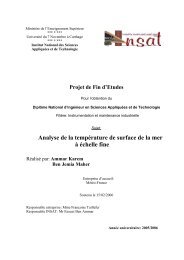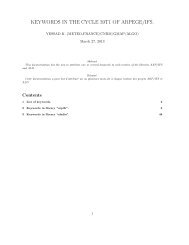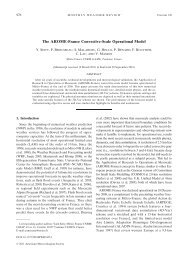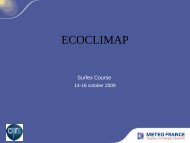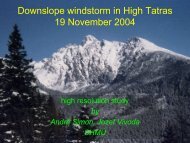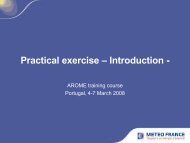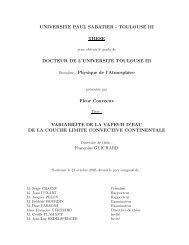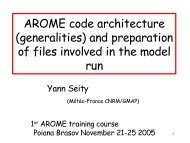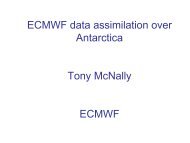3 - Centre National de Recherches Météorologiques - Météo France
3 - Centre National de Recherches Météorologiques - Météo France
3 - Centre National de Recherches Météorologiques - Météo France
Create successful ePaper yourself
Turn your PDF publications into a flip-book with our unique Google optimized e-Paper software.
AmmaAfter the intensive observations periods in 2006, data collectedduring the AMMA campaign were analyzed all along 2007. A firstassessment by the scientific community was ma<strong>de</strong> during theKarlsruhe conference in autumn. The first results are very attractive …Use of data collectedduring the AMMA campaignObservationof the Cold Tongueduring the AMMA/EGEEexperimentsEvery year the Gulf of Guinea is the seat ofan intense cooling along the Equator: this isthe well-known Atlantic Cold Tongue (ACT).This signal is well <strong>de</strong>veloped in the easternpart of the Tropical Atlantic Basin where thethermocline is close to the surface. This coolingbegins usually in May and the seasonalvariations of the sea surface temperatures(SSTs) reach 5 to 7 °C on average. As soon asthis cold anomaly is formed, its northernboundary is in contact with the warm watersof the northern part of the Gulf of Guinea:this generates important north to south SSTgradients as well as a strong discontinuity ofthe sea surface fluxes.One of the main objectives of theAMMA/EGEE program is to i<strong>de</strong>ntify themechanisms which set up the ACT and thecoupling processes between the ACT and theAfrican monsoon. The first results obtainedfrom this program concern the strong SST differencesobserved between 2005 and 2006.These two years are very contrasted in termof ACT formation, since the 2005 ACT is theearliest for the past 25 years; conversely the2006 ACT is one of the latest. Moreover, thistime shift can be related to the <strong>de</strong>lay of theAfrican monsoon observed in 2006 comparedto 2005.The analysis indicates that the ACT coolingin 2005 was sud<strong>de</strong>nly increased after astrong and early wind burst, associated withthe tra<strong>de</strong> winds from the southern hemisphere.This event induced an intense mixingof surface waters with col<strong>de</strong>r waters from theupper thermocline south of the Equator. Thecentral Atlantic also experienced strongwinds as early as April 2005, which largelypreconditioned the surface mixed layersover the whole basin.The VHF windprofiler during AMMAcampaignBetween April 2006 and November 2007,the VHF radar which operated on theNangatchori site (Benin), in or<strong>de</strong>r to provi<strong>de</strong>high-resolution observations of the WestAfrican Monsoon.Every hour, this instrument measured thewind profile above its location from 1.6 to10 km height with a 375 m vertical resolution,giving, in particular, a <strong>de</strong>tailed analysisof the African Easterly Jet and of easterlywaves around 4 km height. Together withlow level phenomena observed by the UHFprofiler, these events have a great influenceon the precipitations occurring in the regionand their consequences on agriculture,health and economical issues.Besi<strong>de</strong>s, the observation of waves in a verylarge spectral range has given importantinformations on the energy budget and onthe momentum transport, thus bringingcomplementary elements about the largescalecirculation and the structure of theatmosphere which characterize of the West-African Monsoon.Finally, the radar reflectivity and the signalwidth on the spectrum allowed an estimationof the atmospheric turbulence. Extractionof the humidity component from theseparameters has contributed to finely tunethe estimation of the water vapour and tocomplete radiometric measurements.The VHF profiler has given very satisfactoryresults during most of its stay in Benin.Hourly measurements have been systematicallycontrolled and sent to the data base ofAMMA Campaign. They inclu<strong>de</strong> the threewind components, radar reflectivity and turbulentdissipation rate. The year 2008 willbe <strong>de</strong>dicated to the scientific exploitation ofthe radar data combined with other remotesensinginstruments installed on the samesite.Humidity biascorrection ofradioson<strong>de</strong>s duringthe AMMA campaignDuring AMMA SOP, the daily number ofradiosoundings performed over WesternAfrica and transmitted on the GlobalTelecommunication System (GTS) was multipliedby 3, but some son<strong>de</strong>s showed systematicbiases.The first objective evaluation showed importantdry humidity biases for stations havingused Vaisala RS80 type radioson<strong>de</strong>s, whichrepresents half of the stations of the AMMAdomain. The station of Niamey (Niger) performed8 soundings / day during the 2 periodsof intensive observations of June,2006 (IOP1, June 20-30, 2006 and IOP2,August 1-15, 2006). During these 2 IOPsVaisala RS92 (good quality) were alternativelylaunched (00, 06, 12, 18 UTC) withVaisala RS80 (03, 09, 15, 21 UTC).The impact of this staggered sampling isvisible in the fig. 1 at Niamey: the dottedline exhibits a serrated shape, where theunrealistic very low values of CAPE correspondto the diagnosis computed from rawRS80 data. A statistically based correctionmethod using the staggered sampling atNiamey is able to diagnose the differentialhumidity bias between the 2 types of Vaisalason<strong>de</strong>s. This bias is plotted in fig. 2, whereone can see 2 maxima: one in the low troposphere(up to 15 %) and the other one inupper troposphere (above 20 %). The solidline in fig.1 corresponds to the CAPE temporalseries with corrected RS80 data; this firstcorrection produces a much more consistentseries. This method was applied to differentsites and validated with in<strong>de</strong>pen<strong>de</strong>nt coinci<strong>de</strong>ntGPS data.After an extensive validation of the methodology,a correction of the whole AMMAdatabase will be performed.1 2 316 . Research and <strong>de</strong>velopment: annual report 2007



